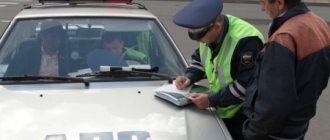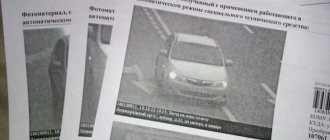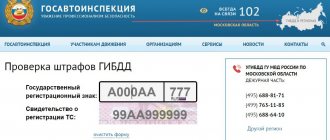Legal basis for the fine
An inspector or a court can impose a fine for non-compliance with traffic rules if there are legal grounds.
The latter is understood as the very fact of violating one or another clause of the traffic rules. This means that the driver must take a specific action that will directly indicate that he is ignoring the Rules. Whether this violation is accidental or intentional does not matter. In this case, the traffic inspector must establish the time and place of the offense and identify the article of the Code of Administrative Offenses under which the driver’s actions fall. In the future, on the basis of the relevant paragraph, administrative liability will be imposed on him. Under the same article, the violating car owner will be given the appropriate punishment.
Typically, sanctions are monetary penalties. For more serious offenses, deprivation of rights may be imposed.
And one more feature - the issued fine will have legal force only if a number of conditions are collectively met. We are talking about the legal capacity and age of the driver. Also, at the time of the violation, there must be a stable situation on the road. In fact, there should be no circumstances forcing the car owner to ignore traffic rules.
Does the inspector have the right to issue 2 or more fines for one stop?
Let's say an inspector stopped you and discovered that you were not wearing a seat belt and your windows were also tinted. In this case, there are two violations, although the second must be proven by measuring a light transmittance device.
And nothing - not a single clause or article of any legal act - prohibits the inspector from issuing as many fines as he likes in the form of decisions for relevant violations. Moreover, the Code of Administrative Offenses directly provides for punishment for each such violation.
Part 1 of Article 4.4 of the Code of Administrative Offenses: 1. If a person commits two or more administrative offenses, an administrative penalty is imposed for each administrative offense committed.
A traffic police officer may issue 2 or more fines for different violations.
Is it legal to impose several fines for the same offense at the same time?
For some violations of traffic rules on the road, the Code of Administrative Offenses provides for sanctions under several articles simultaneously.
Double offenses include:
- driving under the “Entry prohibited” sign and continuing to move along a one-way road against traffic flow - the punishment is provided for in clause 1, clause 3 of Art. 12.16 Code of Administrative Offences;
- changing over a solid marking line into a lane for public vehicles is punishable under Art. 12.19, art. 12.16 Code of Administrative Offences.
It is not possible to issue 2 fines for such violations. In this case, the paragraph of the Code of Administrative Offenses that provides for more severe sanctions for the offense is applied.
The number of penalties for violating traffic rules during the day is practically unlimited. Here everything depends on the act itself, as well as on the loyalty of the traffic inspector. As a general rule, the principle “how many violations – so many fines” is used. However, correcting some offenses takes time, so for technical defects or lack of compulsory motor liability insurance, penalties are usually issued only once a day. At the same time, during one stop, the traffic inspector has the right to impose several fines at once - for each violation he identifies. In the event that liability for a misdemeanor is provided for under several articles of the Code of Administrative Offences, only one of them applies. The one that contains stricter sanctions.
Summation of fines becomes a norm of the code
Traffic police inspectors do not always punish drivers for their violations. They have the right to make do with verbal warnings. This is required by internal regulations of the traffic police, because often a simple conversation works better for drivers than several protocols. In addition, drawing up papers is not a quick task, and traffic police crews already have a lot to worry about. Therefore, police officers at the inspection site independently make decisions about the possible completion of protocols and fines.
However, a new Code of Administrative Offenses (CAO RF) is now being prepared for approval. In the article Art. 21.29 of the code proposes to introduce a so-called “cumulative fine system”, which sums up the number of violations such as exceeding the speed limit, incorrectly driving through a prohibiting traffic light, and so on. If the number of gross violations exceeds a certain limit, the driver will face a very serious punishment.
Comments were made during the discussion of the code, and now it is planned to establish a time period during which the “summation” of punishments occurs. It is proposed to establish a general statute of limitations for bringing administrative liability to one year. At the same time, it is planned to replace the fine for the first minor offense without aggravating circumstances with a warning.
Different fines can be summed up
Now government officials have every right to fine for all violations committed by drivers. As Article 4.4 of the Code of Administrative Offenses of the Russian Federation states, when a person commits two or more administrative offenses, punishment is imposed for each of them. That is, a traffic police officer can add up fines, but only in the case when these same offenses relate to different articles or different parts of one article of the Code of Administrative Offenses of the Russian Federation and are not a consequence of one action.
For example, if a driver is speeding and not wearing a seat belt, a fine can be assessed for each violation separately. And if the driver simultaneously ran a red traffic light and crossed the stop line, then there should be one fine.
According to the general principle of the Code of Administrative Offenses of the Russian Federation, bringing to administrative responsibility twice for the same administrative offense is not allowed.
If the driver was fined twice for the same act, then in this case the second decision must be appealed in court.
Composition of the offense
So, first, let’s deal with one very important term, by understanding which we will, to some extent, get an answer to the main question. An offense is considered to be the totality of all violations of the law prescribed in certain acts.
In order for liability to arise for all acts committed by a person, the object of this violation must be legally competent , that is, correspond to the age established by law, the fact (or facts) of the violation must be proven . In other words, the offense is a list of all driver violations .
Another issue is that our legislation has a fairly extensive list of very similar charges. For example, the wording “Driving on a one-way roadway” and “Driving against the flow” - you must agree, this is the same thing. An unscrupulous traffic police officer may try to fine you for both of these violations, but you should know that this is not legal. The same applies to a fine, for example, for “Unfastened child” and a fine for “Incorrect transportation of a child.”
In such cases, the law establishes that the punishment is levied for only one violation, but a more severe one is chosen. That is, if you were stopped for making a U-turn, or decided to drive in reverse on a highway, it would be good if this is what they write you off as a violation.
In this case, you will have to pay only 2,500 rubles , which is much less than what you can get for failure to comply with the requirements prescribed by road signs and markings. In the second case, you may even be deprived of your rights for up to one year.
Can a traffic police officer issue 2 or more fines for one check?
As a result of the vehicle inspector stopping the vehicle, two offenses were discovered against the driver: he was not wearing seat belts and also had tinted windows. It is worth noting that the extreme point must be proven using a special device - a taumeter.
According to Art. 4.4 Part 1 of the Code of Administrative Offenses, as a result of a person committing two or more administrative offenses, punishment for an administrative offense is assigned for each administrative offense committed. Accordingly, this case cannot be legally prohibited from determining a double fine by police officers in relation to the subject of the offense.
Does an employee have the right to issue several receipts for one stop?
To answer the question of whether an inspector can issue two fines at once for one stop, it is worth simulating the situation. For example, a driver was talking on the phone while driving without a special headset, for which he was stopped by an inspector. During the document check, the traffic police representative also found out that the motorist was driving a vehicle without a compulsory motor liability insurance policy.
In this case, two fines will be issued for one stop. In this case, the inspector will not exceed his powers. Nothing prohibits an employee from issuing as many justified fines as he likes; on the contrary, the law is on the side of the traffic police representative. Part one of Article 4.4 of the Administrative Code regulates that fines must be issued for each offense committed.
Can the traffic police issue 2 fines or several fines for one violation on one day?
This question has its roots in the recent, but still past. Several years ago, the car laws included such a measure to ensure the elimination of violations as renting license plates for a day in order to get the violator to eliminate illegal actions. For example, this was used for tinting. Many drivers with more than 5-6 years of experience remember this security measure.
Today there is no such measure. And, if you were given a fine once, this does not mean that you can safely ride tinted for 24 hours. The bad news is that, since there is basically no removal of license plates and no time to eliminate the violation for 2021, this means that 2, 3... at least 100 fines can be issued in one day. A neglected case looks like this: inspector The traffic police stops your tinted car, fines you, and as soon as you start driving again, it may fine you a second time, and then a third, and so on. Does he have the right to issue 2 or more fines?
It was not for nothing that we mentioned above the presence of a force to hold the driver accountable. The point is that you need to understand what exactly the violation is and in what case a new violation is formed.
Thus, the composition must necessarily include the fact of the violation (objective side), the violated clause of the traffic rules or other legal act (object), the violator (subject) and the driver’s guilt in this violation (subjective side). Without the presence of at least one side of the composition, the punishment is illegal.
So it is with the tinting from our example. The violation does not lie in the tinted windows of the front hemisphere as such, but in driving a car with such tinted windows. If a traffic police officer issued you one fine and tries to issue a second one as soon as you set off, then he is acting illegally. The point here is that the second time there is no subjective side of the violation - the driver is no longer at fault, because he could not eliminate the object in the form of a film on the spot immediately, he needs to at least get to the nearest service center, where this film will be removed for him.
Similarly, the second fine will immediately be illegal in the case of xenon, illegal changes to the design of the vehicle and others - mainly long-term violations and those related to the installation of equipment.
But in the case, for example, with an unfastened seat belt, the fine for the second time will be legal, since each new start of driving without a fastened seat belt forms a new violation. You could have buckled up at the start of the movement, regardless of the previous fine! The same applies to violations such as speeding, prohibited stopping and parking, overtaking and other one-time violations.
Can a traffic police inspector issue 2 or more fines for one violation?
Another case is when one and the same violation constitutes grounds for prosecution under two or more articles of the Code of Administrative Offences. For example, such violations include:
- transportation of a child under 7 years old unfastened in a car seat - here transportation of an unfastened passenger (Article 12.6 of the Code of Administrative Offenses) and violation of the transportation of children (Part 3 of Article 12.23 of the Administrative Code);
- driving under a “brick” on a one-way road and driving against the flow - violation of road signs (Part 1 of Article 12.16 of the Code of Administrative Offenses) and driving against the flow of traffic on a one-way road (Part 3 of Article 12.16 of the Code of Administrative Offenses);
- stopping (not forced) on a bus lane is a violation of markings and signs (Part 4 of Article 12.16 of the Code of Administrative Offences) and violation of the rules for stopping vehicles (Part 1 of Article 12.19 of the Code of Administrative Offences).
This is not a finite list of such violations, for which, in fact, two fines or even more can be issued at once. The Code of Administrative Violations provides a fairly large list of such penalties that are provided for one violation.
But, as you may have noticed, we are talking here about specific and general cases of fines (for example, transporting an unbelted passenger and specifically a child). And it is already illegal to issue two fines for such violations.
Part 5 of Article 4.1 of the Code of Administrative Offenses: 5. No one can bear administrative responsibility twice for the same administrative offense.
Although, there is a flaw in the text of this part. One might think that no one can be held responsible twice, but nothing prohibits fining three or more times. But we will omit this question - judges and officials in any case will not accept the arguments of prosecutors on such grounds.
Something else useful for you:
- Changes to the Code of Administrative Offenses: a new fine for a pedestrian is 2,500 rubles
- The inspector charges a violation, but he has no photo or video evidence - is it legal?
- If you don’t agree with the traffic police protocol: what to do and do you need to sign, what to write and where?
This position is also confirmed by Part 2 of Article 4.4 of the Code of Administrative Offences, which indicates that if two or more sanctions are provided for any violation, then a more stringent, but only one sanction is applied:
2. When a person commits one action (inaction) containing elements of administrative offenses, liability for which is provided for by two or more articles (parts of articles) of this Code and the consideration of cases of which is under the jurisdiction of the same judge, body, official, an administrative penalty is imposed within the limits of the sanction, which provides for the imposition of a more severe administrative punishment on the person who committed the specified action (inaction).
Two or more fines cannot be imposed for one violation; also, for one violation, only one more severe article or part of an article is applied if the Code provides for several of them.
How many fines are issued per day in Moscow as of 2021?
Despite the current legislation, the Moscow State Traffic Inspectorate continues to stubbornly send two or more fines for one offense. The most common of them include regulations that are related to parking and, in particular, stopping under a prohibitory sign.
Car owners daily leave complaints about illegal “chain letters” from traffic inspectors.
The official response to one of these complaints regarding illegal actions of traffic inspectors is provided on the website of the State Public Institution “Administrator of the Moscow Parking Space” for the city of Moscow: “In similar and analogous situations, protocols should be issued only once a day. Otherwise, when you receive several decisions for a similar violation, you must contact the appropriate authority or by phone: +7 (495) 988-30-59 (ext. 10-19) or send a complaint by email. mail."
When drawing up a fine protocol, it is important to remember that a different interpretation of this paragraph of the Code of Administrative Offenses is not acceptable. It is impossible to imply a triple fine for one driver during the day just because in the wording of Art. 4.1 part 5 there is a phrase “no one can be held responsible twice...”. This is illegal and may carry some liability for the police officer himself.
In conclusion, I would like to note that the number of illegal fines that employees issued and collected from the traffic police is steadily growing from year to year solely due to the fault of the drivers themselves. In particular, due to citizens’ ignorance of their legislation and their own laziness, which does not allow them to achieve the truth through the relevant authorities.
Examples of situations
In order to find out how many protocols the traffic police can issue at one time, we suggest that you familiarize yourself with the following situations.
When you may be issued multiple fines
Let's say an inspector sees that you are moving at a clear speed limit. Of course, after waving the baton, you will pull to the side of the road and a servant of the law will approach your car. We strongly recommend that you stop at the first request of the inspectors and do not aggravate the situation by “disobedience to authorities.”
Approaching your car, the traffic police officer sees that you are driving without a T-shirt . Let us remind you that this is not legal.
In addition to the excess, a protocol is also drawn up against you stating that you are moving in an inappropriate manner. When checking the documents, it turns out that your insurance is not in place or has expired. And, yes, now a third protocol will be drawn up.
The license plates on your vehicle are too dirty and legible - the employee has the right to record this too. an additional protocol on your hands .
But if, on top of everything else, it turns out that you have unbelted passengers sitting in front or behind you, and no belt was noticed on you, you and your companions will also be issued another fine .
But it was only one inspector. With this whole bunch of protocols drawn up, you drive away from one checkpoint and now, having driven quite a bit, again breaking the speed limit, you come across another one. Wave the baton, curb, stop. You are facing the same charges because the violations were not eliminated - the tinting is in place, the passengers and you are also not wearing seat belts, you are not wearing a T-shirt, and the first fine for speeding did not teach you anything. The only thing for which a repeated fine will not be issued is for insurance . But more on that in the next chapter.
When I have no right to issue several fines
If a fine was issued to you due to an unregistered change in the design of the car, for example, xenon, they do not have the right to issue you a second one on the same day.
This is due to the fact that in order to eliminate such a violation, you will at least need to get to a service station , which you simply might not have time to get to.
A forgotten MTPL policy is also paid only once a day. After issuing the first fine, you could just go home to correct the mistake.
a closer look at the situation with tinting . When you refused to remove the darkening film and were given the first fine, the indignant inspector could warn the next post that you continued driving in the car without eliminating the violation. Important! You can only be stopped a second time if your windows are closed and the tinting is visible.
Even if it’s winter outside and frost down to -40, employees shouldn’t be concerned about the reason for the open window. When the windows are open, the film cannot be seen, and therefore there is no violation.
If I was fined several times a day for the same thing, is this legal?
June 1, 2021
Suppose you were stopped by a traffic police inspector and, after checking your documents, discovered that your compulsory motor liability insurance policy was expired. Okay, the guilt is obvious. Nothing can be done: a protocol is drawn up, according to which there has been a violation of paragraph 2 of Article 12.37 of the Code of Administrative Offenses, implying a fine of 800 rubles. Then you get into the car and drive further - until the next inspector, who will definitely fine you.
How can this be, you ask, since the fifth paragraph of Article 4.1 of the same Code of Administrative Offenses states that no one should bear administrative responsibility twice for the same violation? But the key point here is that this will be a different offense, because the traffic cop punished you not for the lack of a policy, but for - attention! — driving a vehicle that is not insured in accordance with the established procedure. That is, logically, after the first fine, you do not have the right to drive without eliminating the reason for the punishment. And even if you immediately go to the nearest insurance company to get a policy, the next inspector who meets you on the way has every right to fine you, charging you, in fact, with another episode under the same article. And so on ad infinitum.
So what to do? Call the insurer directly to the spot? If you follow the letter of the law exactly, then yes. However, this is not always possible, as you understand. Therefore, it is most reasonable to continue the path towards the intended goal - or rather, slightly adjust it by adding an insurance company as an intermediate point. And when meeting with another inspector (if one suddenly happens), ask for leniency, trying to be as convincing as possible - of course, you will have to show a fresh protocol on the offense as proof of your good intentions. But it’s not a fact that this will help.
This is one of the most significant cases when you have to make a choice about what to do correctly: solve the problem on the spot (we are not talking about an attempt to corrupt the inspector!) or take risks, but drive with a known violation. In other cases, the issue is resolved more simply. Let's say, if an inspector gives you a fine for not wearing a seat belt, then you can fasten your seat belt right on the spot - and thereby eliminate the cause of the violation. But in the case of, for example, illegal tinting, you can try to rip off the film, so to speak, without leaving the cash register - and continue on your way being clean before the law. If you can’t do this, then it makes sense to turn on the emergency lights and go to a service center, where they will help you get rid of the tint - clause 2.3.1 of the Road Traffic Rules allows you to do this.
Error in the text? Select it with your mouse! And press: Ctrl + Enter
Methods of protection
To protect yourself, we recommend:
- Use a DVR in your car. The fixing device will help prove illegal actions on the part of law enforcement officers on the road.
- Have witness testimony . It doesn’t matter whether it’s your passenger or just a person who agreed to confirm your innocence.
- In case of any illegal attempts to take money from you “for nothing” - find out all the personal information of the inspector . Full name, position and department to which the employee is assigned. You can subsequently file a complaint with the appropriate department.
- Lawyers who know all the nuances of the law protect you










